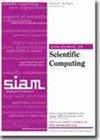On the Convergence of Monolithic Multigrid for Implicit Runge–Kutta Time Stepping of Finite Element Problems
IF 2.6
2区 数学
Q1 MATHEMATICS, APPLIED
引用次数: 0
Abstract
SIAM Journal on Scientific Computing, Ahead of Print.Abstract. Finite element discretizations of time-dependent problems also require effective time-stepping schemes. While implicit Runge–Kutta methods provide favorable accuracy and stability properties, they give rise to large and complicated systems of equations to solve for each time step. These algebraic systems couple all Runge–Kutta stages together, giving a much larger system than for single-stage methods. We consider an approach to these systems based on monolithic smoothing. If stage-coupled smoothers possess a certain kind of structure, then the question of convergence of a two-grid or multigrid iteration reduces to convergence of a related strategy for a single-stage system with a complex-valued time step. In addition to providing a general theoretical approach to the convergence of monolithic multigrid methods, several numerical examples are given to illustrate the theory and show how higher-order Runge–Kutta methods can be made effective in practice. Reproducibility of computational results. This paper has been awarded the “SIAM Reproducibility Badge: Code and Data Available” as a recognition that the authors have followed reproducibility principles valued by SISC and the scientific computing community. Code and data that allow readers to reproduce the results in this paper are available at https://github.com/rckirby/CodeForMMGPaper as well as in the supplemental material.
论有限元问题隐式 Runge-Kutta 时间步进的单片多网格收敛性
SIAM 科学计算期刊》,提前印刷。 摘要时间相关问题的有限元离散化也需要有效的时间步进方案。虽然隐式 Runge-Kutta 方法具有良好的精度和稳定性,但它们会产生庞大而复杂的方程系统,需要解决每个时间步的问题。这些代数系统将所有 Runge-Kutta 阶段耦合在一起,从而产生一个比单级方法大得多的系统。我们考虑采用基于整体平滑的方法来解决这些问题。如果阶段耦合平滑器具有某种结构,那么双网格或多网格迭代的收敛问题就可以简化为具有复值时间步长的单阶段系统的相关策略的收敛问题。除了提供单片多网格方法收敛的一般理论方法外,还给出了几个数值示例来说明理论,并展示了高阶 Runge-Kutta 方法在实践中的有效性。计算结果的可重复性。本文被授予 "SIAM 可重复性徽章":代码和数据可用性",以表彰作者遵循了 SISC 和科学计算界重视的可重现性原则。读者可以通过 https://github.com/rckirby/CodeForMMGPaper 以及补充材料中的代码和数据重现本文的结果。
本文章由计算机程序翻译,如有差异,请以英文原文为准。
求助全文
约1分钟内获得全文
求助全文
来源期刊
CiteScore
5.50
自引率
3.20%
发文量
209
审稿时长
1 months
期刊介绍:
The purpose of SIAM Journal on Scientific Computing (SISC) is to advance computational methods for solving scientific and engineering problems.
SISC papers are classified into three categories:
1. Methods and Algorithms for Scientific Computing: Papers in this category may include theoretical analysis, provided that the relevance to applications in science and engineering is demonstrated. They should contain meaningful computational results and theoretical results or strong heuristics supporting the performance of new algorithms.
2. Computational Methods in Science and Engineering: Papers in this section will typically describe novel methodologies for solving a specific problem in computational science or engineering. They should contain enough information about the application to orient other computational scientists but should omit details of interest mainly to the applications specialist.
3. Software and High-Performance Computing: Papers in this category should concern the novel design and development of computational methods and high-quality software, parallel algorithms, high-performance computing issues, new architectures, data analysis, or visualization. The primary focus should be on computational methods that have potentially large impact for an important class of scientific or engineering problems.

 求助内容:
求助内容: 应助结果提醒方式:
应助结果提醒方式:


